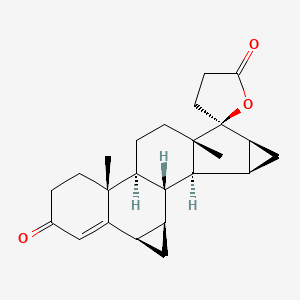Attribution Statement: LactMed is a registered trademark of the U.S. Department of Health and Human Services.
NCBI Bookshelf. A service of the National Library of Medicine, National Institutes of Health.
Drugs and Lactation Database (LactMed®) [Internet]. Bethesda (MD): National Institute of Child Health and Human Development; 2006-.
CASRN: 67392-87-4

Drug Levels and Effects
Summary of Use during Lactation
Drospirenone is a progestin that is an analogue of spironolactone. It has antimineralocorticoid and antiandrogenic activities. Amounts in milk are very low and no adverse effects on the breasted infant or milk supply are expected. Based on the available evidence, expert opinion holds that nonhormonal methods are preferred during breastfeeding and progestin-only contraceptives are preferred over combined oral contraceptives in breastfeeding women, especially during the first 4 weeks postpartum. For further information, consult the record entitled, Contraceptives, Oral, Combined.
Drug Levels
Maternal Levels. Six women who were between 1 week and 3 months postpartum received a single dose of drospirenone 3 mg plus ethinyl estradiol 30 mcg. Milk was collected for 72 hours after the dose in 2 of the women in whom half-lives in breastmilk were 8.3 and 15.5 hours. The average peak milk level in the 6 women was 13.5 mcg/L at 2.8 hours after the dose. The average drospirenone milk level in the first 24 hours was 3.7 mcg/L (range 1.4 to 7 mcg/L). The authors estimated that a fully breastfed infant would receive a drospirenone dose of about 3 mcg daily.[1] Using the average milk level of drospirenone, an exclusively breastfed infant would receive 1.1% of the weight-adjusted maternal dosage of drospirenone.
Twelve women who had weaned their infants, but were still lactating were given non-micronized oral drospirenone 4 mg daily (Slinda-Exeltis, Germany). Blood and milk samples were obtained at 12 time points up to 120 hours after at least 7 days of use. The average peak concentration in milk was 10.3 mcg/L at 3 hours after the dose and the average milk concentration over 24 hours would be 5.6 mcg/L. Using the standard milk intake value of 150 mL/kg daily, the infant would receive an average of 0.84 mcg/kg of drospirenone daily, which represent a weight-adjusted relative infant dose of 1.25% of the maternal dose.[2]
Infant Levels. Relevant published information was not found as of the revision date.
Effects in Breastfed Infants
Relevant published information was not found as of the revision date.
Effects on Lactation and Breastmilk
Relevant published information was not found as of the revision date.
Alternate Drugs to Consider
Etonogestrel, Intrauterine Copper Contraceptive, Oral Levonorgestrel, Intrauterine Levonorgestrel, Levonorgestrel Implant, Medroxyprogesterone Acetate, Norethindrone, Progesterone
References
- 1.
- Blode H, Foidart JM, Melka R. Transfer of drospirenone to breast milk after a single oral administration of 3 mg drospirenone + 30 mcg ethinylestradiol to healthy lactating women. Eur J Contracept Reprod Health Care 2001;6:167-71. [PubMed: 11763981]
- 2.
- Melka D, Kask K, Colli E, Regidor PA. A single-arm study to evaluate the transfer of drospirenone to breast milk after reaching steady state, following oral administration of 4 mg drospirenone in healthy lactating female volunteers. Womens Health (Lond) 2020;16:1745506520957192. [PMC free article: PMC7485149] [PubMed: 32903172]
Substance Identification
Substance Name
Drospirenone
CAS Registry Number
67392-87-4
Drug Class
Breast Feeding
Milk, Human
Aldosterone Antagonists
Contraceptive Agents, Female
Contraceptives, Oral, Synthetic
Mineralocorticoid Receptor Antagonists
Disclaimer: Information presented in this database is not meant as a substitute for professional judgment. You should consult your healthcare provider for breastfeeding advice related to your particular situation. The U.S. government does not warrant or assume any liability or responsibility for the accuracy or completeness of the information on this Site.
- User and Medical Advice Disclaimer
- Drugs and Lactation Database (LactMed) - Record Format
- LactMed - Database Creation and Peer Review Process
- Fact Sheet. Drugs and Lactation Database (LactMed)
- Drugs and Lactation Database (LactMed) - Glossary
- LactMed Selected References
- Drugs and Lactation Database (LactMed) - About Dietary Supplements
- Breastfeeding Links
- PMCPubMed Central citations
- PubChem SubstanceRelated PubChem Substances
- PubMedLinks to PubMed
- Review Contraceptives, Oral, Combined.[Drugs and Lactation Database (...]Review Contraceptives, Oral, Combined.. Drugs and Lactation Database (LactMed®). 2006
- Review Ethinyl Estradiol.[Drugs and Lactation Database (...]Review Ethinyl Estradiol.. Drugs and Lactation Database (LactMed®). 2006
- Review Oral Levonorgestrel.[Drugs and Lactation Database (...]Review Oral Levonorgestrel.. Drugs and Lactation Database (LactMed®). 2006
- Review Desogestrel.[Drugs and Lactation Database (...]Review Desogestrel.. Drugs and Lactation Database (LactMed®). 2006
- Review Dienogest.[Drugs and Lactation Database (...]Review Dienogest.. Drugs and Lactation Database (LactMed®). 2006
- Drospirenone - Drugs and Lactation Database (LactMed®)Drospirenone - Drugs and Lactation Database (LactMed®)
Your browsing activity is empty.
Activity recording is turned off.
See more...
